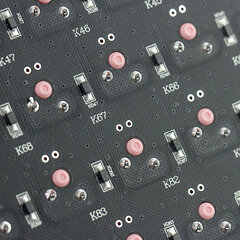 6
6
Akko 3108v2 Monet's Pond Review - Fishing for Luck
Software & Performance »Disassembly
The two-piece plastic case construction requires one to carefully pry apart the interlocking tabs, and to my pleasant surprise, it actually happened easily and without any visible damage. Start at the bottom and work your way around the sides, after which it will get easier on the fourth side. We see that the top panel piece is quite thin and houses diffusers for the indicator LEDs at the front of the PCB.
To remove the bottom panel, you need to remove two screws towards the top as seen above. No keycap removal necessary for these, and I was surprised by the lack of screws at the bottom, too. Once done, the plate/PCB piece lifts upwards and away from the bottom panel.
An internal USB cable extends from a daughter PCB on the case, which houses the Type-C connector. The daughter PCB is screwed in securely, and there's little else to see on the case. Both case panels are made out of ABS plastic, and the middle piece has the switches which are soldered to the matte black PCB go through a steel plate. The steel plate is white, and it would have been nice to see it in a matching turquoise. No sound-absorbing foam here, so any sound affecting the case can reverberate through it.
Solder quality is very good for all the components, and we see confirmation on the PCB that it was made for the Akko 3108 keyboard design. The pink stem of the Gateron Pink switches is also visible, and it ends up being a 3-pin mechanical switch. Powering the keyboard is a Vision VS11K15A 32-bit ARM Cortex-M0 USB microcontroller, which has been used in some other keyboards we have covered before. The MCU actually supports basic backlighting, including RGB LEDs to an extent, so Akko could have added single color LEDs to all 108 keys if it wanted to. The company leaves it to users to mod in LEDs if desired, but I doubt many will. All the components, including the switches, LEDs, and capacitors, are soldered to a multi-layered PCB, and a side view showcases more of the Gateron Pink switches, stabilizers, and the steel plate, which unfortunately can't be removed without desoldering. You can lube the stabilizers more if you wish, although I found it sufficient given the rest of the keyboard is not designed to take advantage of it.
Before we move on, be advised that disassembly may void the warranty and that TechPowerUp is not liable for any damages incurred if you decide to go ahead and do so anyway.
Apr 8th, 2025 02:03 EDT
change timezone
Latest GPU Drivers
New Forum Posts
- Kindly help in Identifying GPU and Suitable bios (9)
- AMD RX 9070 XT & RX 9070 non-XT thread (OC, undervolt, benchmarks, ...) (84)
- 12v lines 0 reads occansionally (3)
- Asus X670E Crosshair Crashes (7)
- 9070XT or 7900XT or 7900XTX (122)
- USB case with dual USB-C and dual USB-A (7)
- The coffee and tea drinkers club. (247)
- The easiest way to connect the BOOTSEL test metal terminal and the GND terminal.... (1)
- Anyone with true HDDs still around here? (337)
- is it worth using ssd with usb2? (12)
Popular Reviews
- The Last Of Us Part 2 Performance Benchmark Review - 30 GPUs Compared
- UPERFECT UStation Delta Max Review - Two Screens In One
- ASUS Prime X870-P Wi-Fi Review
- PowerColor Radeon RX 9070 Hellhound Review
- Upcoming Hardware Launches 2025 (Updated Apr 2025)
- MCHOSE L7 Pro Review
- Sapphire Radeon RX 9070 XT Pulse Review
- Corsair RM750x Shift 750 W Review
- Sapphire Radeon RX 9070 XT Nitro+ Review - Beating NVIDIA
- DDR5 CUDIMM Explained & Benched - The New Memory Standard
Controversial News Posts
- NVIDIA GeForce RTX 5060 Ti 16 GB SKU Likely Launching at $499, According to Supply Chain Leak (161)
- MSI Doesn't Plan Radeon RX 9000 Series GPUs, Skips AMD RDNA 4 Generation Entirely (146)
- Microsoft Introduces Copilot for Gaming (124)
- AMD Radeon RX 9070 XT Reportedly Outperforms RTX 5080 Through Undervolting (119)
- NVIDIA Reportedly Prepares GeForce RTX 5060 and RTX 5060 Ti Unveil Tomorrow (115)
- Over 200,000 Sold Radeon RX 9070 and RX 9070 XT GPUs? AMD Says No Number was Given (100)
- NVIDIA GeForce RTX 5050, RTX 5060, and RTX 5060 Ti Specifications Leak (97)
- Nintendo Switch 2 Launches June 5 at $449.99 with New Hardware and Games (92)













